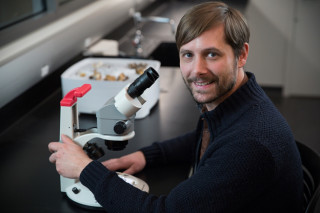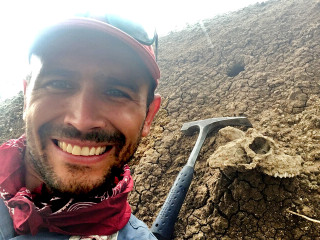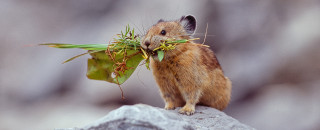Sustaining Biodiversity
Sustaining Biodiversity Faculty Research Cluster
Biodiversity is the richness of life on Earth, past and present. It encompasses genes, genotypes, populations, species and ecosystems, essentially all levels in the extraordinary hierarchy of organization and structure of organisms. It is also the natural capital of our planet, through which we derive vital resources that underpin all livelihoods and cultures. Humans have greatly accelerated the loss of biodiversity to our own detriment, thus creating an urgent need for outstanding research and effective public outreach. Increasing scientific knowledge and public understanding of biodiversity can lead to decisions that yield more sustainable economic growth and reduce human impacts on ecosystems.
The Natural History Museum of Utah and the University of Utah are developing a faculty cluster focused on Sustaining biodiversity, where collections-based biodiversity research is combined with learning research for a novel interdisciplinary emphasis that strongly supports the University’s commitment to sustainability. This new research emphasis will combine science, practical applications, and learning science in the areas of genomics, conservation biology, urban ecology, paleoecology, visualization, and informal learning. It will complement related research at the NHMU, in the School of Biological Sciences, the departments of Anthropology, Educational Psychology, Geography, Geology & Geophysics, City & Metropolitan Planning, and at the Scientific Computing and Imaging Institute.
By connecting collections-based biodiversity science to policy and public understanding, the Sustaining Biodiversity faculty can assist the University of Utah researchers and students in addressing and communicating important issues facing resource management in the Intermountain West and beyond. The Museum will serve as the bridge for understanding the connection between formal and informal learning and testing educational ideas in an authentic context with diverse audiences. We are seeking collaborative faculty who will join us in exploring the diversity in the world around us and communicating its value and impact on the public.
Phase I

In the 2015-2016 academic year—Phase I of the establishment of this cluster—the search committee hired Dr. Bryn Dentinger as Associate Professor jointly between the Museum and the School of Biological Sciences, filling the genomics position. He formerly was Senior Research Leader of Comparative Fungal Biology at the Royal Botanic Gardens, Kew. Dr. Dentinger is broadly interested in documenting, describing, and understanding the origin and evolution of global fungal diversity. His research makes use of diverse lines of enquiry and tools that attempt to synthesize principles of fungal evolution and relationships of fungi with other organisms to understand who, how and why fungi are so diverse and ecologically critical. Collections-based studies that integrate fieldwork and molecular data form the core of his research that encompasses many areas, such as molecular ecology, comparative genomics, historical biogeography, coevolution, taxonomy, and conservation. His lab employs a variety of techniques, from simple field experiments to high-throughput sequencing, microscopy and culturing, to molecular phylogenetics. He currently has external funding for two projects focusing on the fungus-growing ant symbiosis and the evolutionary radiation of porcini mushrooms. These projects include fieldwork in South America, North America, Malaysia, and Siberia. In addition to international research, Dr. Dentinger, his students and volunteers are also committed to documenting fungi in Utah and the wider region of the Intermountain West.
Phase II

In the second phase of the Sustaining Biodiversity cluster, the Museum and the Department of Anthropology jointly hired Dr. Tyler Faith for the paleoecology position. He joined us from the University of Queensland in Australia, where he was a Senior Research Fellow in the Archaeology Program. Tyler’s research broadly addresses the relationships between fossil mammal communities, environmental change, and human-environment interactions, with a focus on the African record. He approaches these relationships through the analysis of vertebrate fossils from archaeological and paleontological sites, which sets the stage for addressing questions about (i) how climate change and human impacts have shaped terrestrial ecosystems through time, (ii) the causes and consequences of large mammal extinctions through the Pleistocene, and (iii) the role of ecological change in human evolution. Tyler has long conducted fieldwork in Kenya and South Africa, and has recently developed a new project exploring and documenting the vertebrate fossil assemblages from high-elevation caves in Utah and Idaho.
Phase III
For the third phase of the Sustaining Biodiversity cluster, the Museum partnered with the Department of Educational Psychology to hire Dr. Lynne Zummo in the joint position of Curator of Learning Sciences and Assistant Professor of Learning Sciences. With a background in science education, Lynne studies how people learn. Specifically, she tries to understand how people’s cultural backgrounds and ideas about themselves influence how they make sense of science-related social issues, like climate change and COVID-19. To do this, she studies what people do and say when participating in learning activities together, both in classrooms and in informal contexts, from museums to digital spaces. Ultimately, the goal of this research is to inform the design of new learning environments and activities that support all people in making sense of their worlds in ways that align both with who they are and with science.
Phase IV

In the final phase of the cluster hire, the Museum collaborated with the Department of City & Metropolitan Planning to hire Dr. Alexandra Ponette-González in the joint position of Curator of Urban Ecology and Associate Professor of City & Metropolitan Planning. Alexandra studies how changes in our atmosphere caused by fire, dust, urban pollution, and pests circle back to affect diverse ecosystems on land - from tropical forest to urban settings. With colleagues at multiple institutions across the US, she is currently working on two new projects. The first project examines equity and environmental justice in the planning and management of urban forests (including Salt Lake City). The second project shines a magnifying glass on the diverse suite of tiny particles, including soot and microplastics, that flow through forest canopies when it rains. In the near future, she plans to utilize museum-based collections to develop new ecological questions focused on Salt Lake City and surrounding regions.
Museum and University Research Resources
The Sustaining Biodiversity cluster will be centered in the Natural History Museum of Utah, with research based in collections, public galleries, and outreach programs. Museum collections total 1.6 million specimens, with strengths in archaeology, botany, entomology, paleontology, and vertebrates. Collections databases currently are being converted to EMu or Arctos, for networking and digital image storage capability. The Museum has on-site and statewide access to both public (families, adults) and school audiences of more than 500,000 individuals annually, which may serve as a resource for research and as an audience for outreach. The Museum’s new home, the spectacular, award-winning Rio Tinto Center, opened in late 2011 with new offices, exhibits, laboratories, and collections storage.
The University’s Global Change and Sustainability Center provides coordination of multidisciplinary research, graduate student fellowships, grant-writing support, and other opportunities to member faculty. Centers and Institutes on campus, including the DIGIT GIS Lab and the Scientific Computing and Imaging Institute (SCI), may provide further opportunities for collaboration. Extensive analytical capabilities are available campus-wide as part of core facilities.
The University of Utah has a network of field stations that provide valuable environments for research and teaching. These include Range Creek Canyon (managed by the Museum), Rio Mesa, Taft-Nicholson, plus Red Butte Canyon Research Natural Area.
Explore Partner Departments and Programs
- Natural History Museum of Utah
- Department of Anthropology
- Department of Biology
- Department of City and Metropolitan Planning
- Department of Geology & Geophysics
- Department of Educational Psychology
- Department of Geography
- Scientific Computing and Imaging Institute
- Honors College
- Global Change and Sustainability Center
